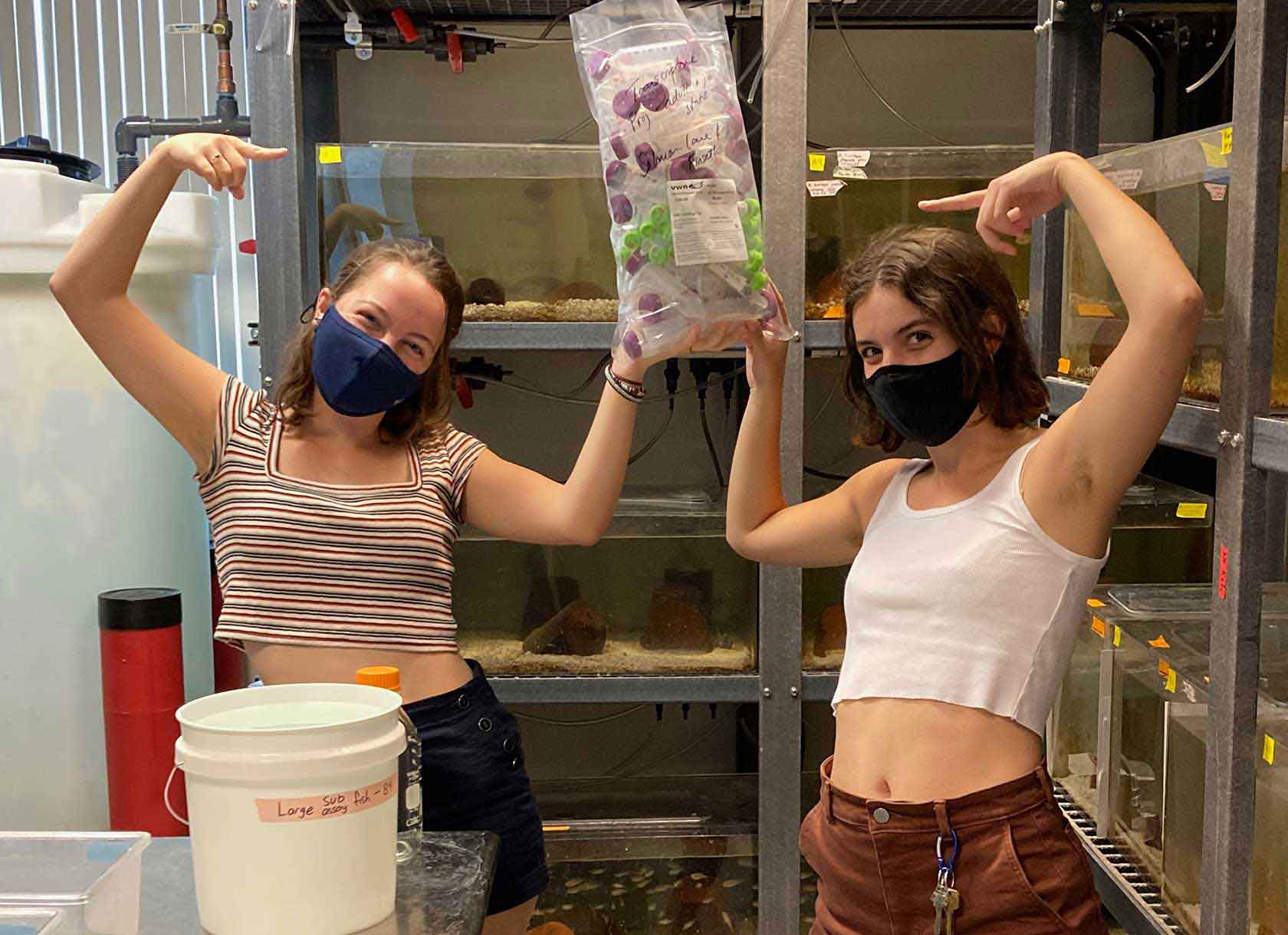
For years, neuroscientists have been asking the deceptively simple question: Why do animals behave the way they do? Isabela Harmon ’22 and Jessica Maurice ’22 are working with Assistant Professor of Biology Tessa Solomon-Lane to fill in pieces of this puzzle by studying dominance hierarchies in Burton’s Mouthbrooder, a species of highly social fish in the African cichlid family.
Adult male cichlids change their phenotype, their observable physical traits, depending on their position within social hierarchies, making it easy to tell the vibrantly colored dominant fish from the silvery subordinates. Currently, Harmon and Maurice are interested in understanding whether juvenile cichlids—whose coloration does not change until sexual maturity—establish dominance hierarchies in the same ways as adults. “The way that species develop in early life impacts their social interactions and dynamics in the future,” Harmon says. “We’re trying to put together a more complete picture of how behaviors and dominance hierarchies are formed by studying the cichlids’ behaviors, hormone levels, and genomic expression, both before and after sexual maturation.”
According to Solomon-Lane, studies that involve animal subjects—including humans—typically necessitate this kind of multi-pronged approach. “Behavioral neuroscience is fascinating because you’re not just studying a disembodied brain, you’re looking at a whole animal,” she says. “Individuals with similar brain chemistry might behave very differently. Or individuals with very different brain chemistry might behave quite similarly. That’s why we look at behavior from multiple angles.”
The implications of this research extend beyond the lab. “All the genes we’re looking at and the hormones that Jess and Bela were measuring are relevant to and shared by every social vertebrate, including humans,” says Solomon-Lane. “So even though we’re asking questions about status establishment and social roles in fish, other social species have also evolved from a common ancestor and may have very similar ways of achieving and performing social roles.”
To gather data on the behavior of the cichlids, Solomon-Lane placed two fish at a time in an environment with a plant and a pot (potential territories) and left them to establish a social relationship over the course of a day or a week. “With juveniles and adults, dominance is typically influenced by size and by which fish gets to occupy the territory,” Harmon says. “If the smaller one starts heading toward the pot in the tank, the larger will probably start being aggressive toward it—not to actually harm it, but to establish their roles in the hierarchy.” As a comparison, Solomon-Lane also ran these experiments with adult male cichlids, adding the element of sexual competition by introducing two female fish into the environment.
Throughout the pandemic, Solomon-Lane sent videos of the cichlids to Harmon and Maurice, who used a behavioral information software to code the footage for different factors. By quantifying aggression, displacement, and location within different territories, they could precisely describe how individual fish interacted with their environment and with each other as time progressed.
This summer, Harmon and Maurice finally returned to Solomon-Lane’s lab in Claremont to conduct their research in person. They focused on measuring two hormones: testosterone, which is linked to aggression and reproduction, and cortisol, which is linked to the stress response. Previous research has established that dominant adult cichlids have higher levels of testosterone and subordinates have higher levels of cortisol. But because juvenile cichlids are not yet reproductively mature, Solomon-Lane’s lab was interested in discovering whether they would express these hormones in patterns similar to adults.
Interestingly, Harmon’s and Maurice’s results showed the dominant juvenile cichlids did have higher levels of testosterone. “High levels of testosterone are often thought to be associated with aggressive behaviors, but often it is the situations that require aggression that actually lead to increased testosterone,” says Solomon-Lane. “In this case, it seems that the social context was influencing the juvenile cichlids’ hormonal levels.”
In addition to gathering behavioral and hormonal data, Solomon-Lane’s lab is working with Assistant Professor of Biology Findley Finseth to extract RNA from the cichlids’ brains and send it out for full analysis of the neural transcriptome (every gene that is expressed in the brain). “Our work in pinpointing correlations across gene expression, reproductive status, time periods, hormone levels, and developmental stages may potentially enhance the field’s understanding of individual variation in social behavior,” says Maurice.
While the cichlids may have been focused on establishing dominance hierarchies, the researchers in Solomon-Lane’s lab are much more interested in fostering an atmosphere of collaboration and support. “For quality science to take place, there must be a setting of mutual trust and respect,” says Maurice. “A lot of the work was extremely collaborative—my actions would directly affect the following actions of my lab mates and vice versa—so the circumstances made it extremely important to voice where I was confused and to support the work and accomplishments of my lab mates.”

